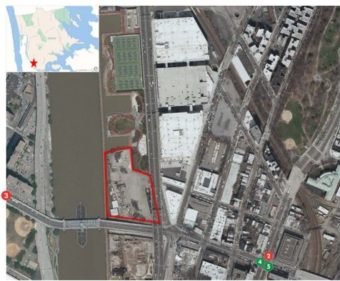
Partial Site Rendering Image Credit: NYCEDC
A Bronx not-for-profit sues City over the sale of waterfront property to a private developer. The City sold Pier 5 to a private developer to facilitate the construction of the Bronx Point development. Pier 5 is a 4.4 acre plot of land bounded by Mill Pond Park to the North, the 149th Street Bridge to the South, the Major Deegan Expressway to the East and the Harlem River to the West. The development anticipates mixed-affordable housing, state of the art community facilities, open spaces and a waterfront esplanade. To read Cityland’s prior coverage of the Bronx Point development click here.
On October 17, 2017, City Council approved the disposition of Pier 5. The Bronx Council for Environmental Quality commenced an Article 78 action on February 15, 2018, claiming that that Pier 5 is a continuation of Mill Pond Park, effectively making it City-owned parkland. The Bronx Council for Environmental Quality also claimed that the City illicitly transferred the property to a private developer. To dispose of City-owned parkland, the City must generally receive legislative approval if the land ceases to be used for parkland purposes. The Bronx Council for Environmental Quality is a Bronx-based not-for-profit dedicated to improving the borough’s air, land and water quality. The other plaintiff is Chauncy Young, a Bronx resident.
In response to the allegations, the City claimed that Pier 5 was not parkland and that it was not illicitly transferred to developers. In order to establish that a property was dedicated for public use or as a park, the challenger must present express or implied evidence that the land was a public park. That evidence includes express language in deeds or legislative enactments, the way the parties used the land, or the way the parties publicly represented the land.
The New York County Supreme Court found no such express or implied indicators evincing that Pier 5 should be considered parkland. The court looked at the fact Pier 5 is not mapped as parkland on the City Map nor the Bronx Borough Presidents’ map, unlike the rest of Mill Pond Park. The court also considered the lack of official city acts declaring the land as parkland.
In determining Pier 5 was not implied to be a park, the court considered the declarations and circumstances surrounding the use of the land. The court considered the documents from the Yankee Stadium Redevelopment Project and looked at the nature of the Parks Department’s ownership and control of the land. The court ultimately concluded that even though the Parks Department had jurisdiction over the property, it always kept it closed to the public (except for a few occasions where environmental tests, circus and carnival events were conducted). The court also articulated that even though the Parks Department and Bronx Borough president’s office spoke about the potential for future park use on the property, it should not be inferred to mean that the land was in fact dedicated as parkland. The court stated “mere consideration of future park use of the parcel do not demonstrate a present, fixed, and unequivocal intent to dedicate the land as parkland.” The Supreme Court dismissed all claims and the Bronx Council for Environmental Quality appealed.
On November 7, 2019, the Appellate Division affirmed the lower court stating that there was never continuous use as a public park, that the Parks Department jurisdiction and management did not evince an intention to create parkland and occasional use of the land does not make the lot parkland.
(Bronx Council for Environmental Quality v. City of New York, 2019 N.Y. Slip Op. 08005[U] [1st Dept 2019])
By: Jason Rogovich (Jason Rogovich is the CityLaw Fellow and New York Law School Graduate, Class of 2019)


The City again allows development by the coast instead of retreating from building by the coasts and allowing land by the water to be used as a natural sponge as water rises. Instead of allowing for light, air, trees and greenery to help mitigate against the effects of climate change and high incidences of asthma the City allows another building to rise when the city is inundated with towers that sit with many empty units that could be taken over for low income New Yorkers.
Section 383 of the City Charter prohibits the alienation of the City’s waterfront. The caption states that this is waterfront property. It should have been inalienable as waterfront.